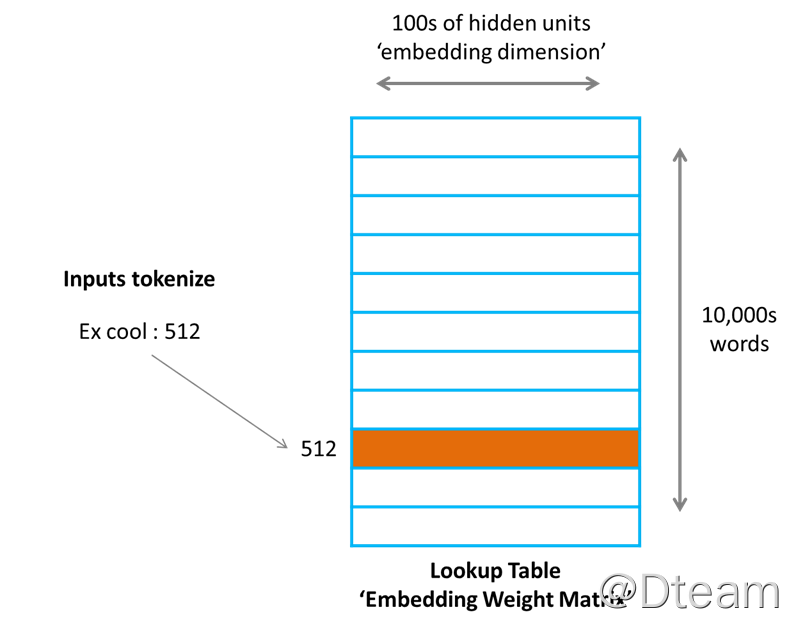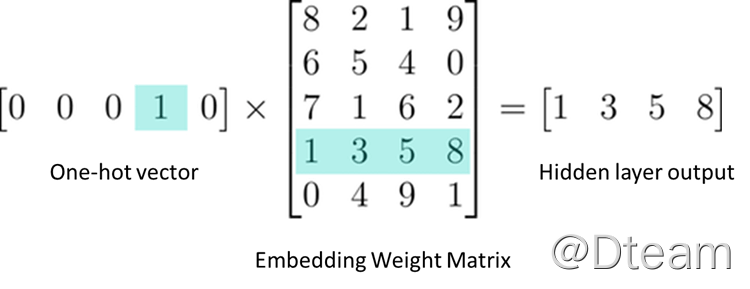

土法炮制:Embedding 层是如何实现的?
source link: https://blog.dteam.top/posts/2020-01/%E5%9C%9F%E6%B3%95%E7%82%AE%E5%88%B6embedding%E5%B1%82%E6%98%AF%E5%A6%82%E4%BD%95%E5%AE%9E%E7%8E%B0%E7%9A%84.html
Go to the source link to view the article. You can view the picture content, updated content and better typesetting reading experience. If the link is broken, please click the button below to view the snapshot at that time.

在本系列的前面两篇文章(第一篇和第二篇)中,我们已经看到了如何用 TensorFlow 实现一些典型的神经网络层:Dense、Conv2D、MaxPooling、Dropout、Flatten。本文将介绍另一个典型层的实现:Embedding。
使用 Keras 的做法
同样,按照老规矩,先看看 Keras 的 Embedding 使用,然后再用 TF 实现。这里的示例也同样来自于一个常见的例子,imdb 评论分类。
import tensorflow as tf
from tensorflow.keras.datasets import imdb
from tensorflow.keras import preprocessing
max_features = 10000
maxlen = 20
# 加载数据
(x_train, y_train), (x_test, y_test) = imdb.load_data(num_words=max_features)
# 预处理数据,将数据分割成相等长度
x_train = preprocessing.sequence.pad_sequences(x_train, maxlen=maxlen)
x_test = preprocessing.sequence.pad_sequences(x_test, maxlen=maxlen)
# 模型定义
model = tf.keras.models.Sequential([
tf.keras.layers.Embedding(max_features, 8, input_length=maxlen),
tf.keras.layers.Flatten(),
tf.keras.layers.Dense(1, activation='sigmoid')
])
model.compile(optimizer='rmsprop',
loss='binary_crossentropy',
metrics=['accuracy'])
# 训练
model.fit(x_train, y_train, epochs=10, batch_size=32, validation_split=0.2)
# 预测
print(y_train[:3])
print(model.predict_classes(x_test[:3]).flatten())
使用 TF 实现自定义结构
Embedding 本质上是一个全连接层,形式上,可以将其视为一个索引表,每一行对应一个单词相应的稠密向量,如下图(摘自 What the heck is Word Embedding ):

通常,会采用单词在文件中的索引来编码,因此从效果上来讲,one-hot 后跟一个全连接层等价于一个 embedding 层,因为相乘之后,得到值就是单词对应的向量,如下图(摘自 What the heck is Word Embedding ):

介绍完基本情况,那么接下来就看看如何实现吧。
MyDense
跟前几篇的代码差不多,换了一个激活函数。
class MyDense(Layer):
def __init__(self, units=32):
super(MyDense, self).__init__()
self.units = units
def build(self, input_shape):
self.w = self.add_weight(shape=(input_shape[-1], self.units),
initializer='random_normal', trainable=True)
self.b = self.add_weight(shape=(self.units,),
initializer='random_normal', trainable=True)
def call(self, inputs):
return tf.nn.sigmoid(tf.matmul(inputs, self.w) + self.b)
MyEmbedding
自定义 Embedding 层,注意:
- 继承 Layer 的规范,实现 build 和 call 。
- build 负责初始化权重和偏置,来自 Layer 。注意它们的 shape:
- 权重:单词个数 x Embedding 维数
- 偏置:无,因为不需要
- call 负责计算(返回对应 word index 的权重),来自 Layer 。
class MyEmbedding(Layer):
def __init__(self, input_unit, output_unit):
super(MyEmbedding, self).__init__()
self.input_unit = input_unit
self.output_unit = output_unit
def build(self, input_shape):
self.embedding = self.add_weight(shape=(self.input_unit, self.output_unit),
initializer='random_normal', trainable=True)
def call(self, inputs):
return tf.nn.embedding_lookup(self.embedding, inputs)
MyFlatten
跟上一篇差不多,shape 变了而已。
class MyFlatten(Layer):
def __init__(self):
super(MyFlatten, self).__init__()
def call(self, inputs):
shape = inputs.get_shape().as_list()
return tf.reshape(inputs, [shape[0], shape[1] * shape[2]])
MyModel
与前文代码差别不大,在更新准确率之前需要对预测值做变换。
class MyModel(Layer):
def __init__(self, layers):
super(MyModel, self).__init__()
self.layers = layers
def call(self, inputs):
x = self.layers[0](inputs)
for layer in self.layers[1:-1]:
x = layer(x)
return self.layers[-1](x)
def train(self, x_train, y_train, epochs = 5):
loss = tf.keras.losses.BinaryCrossentropy()
optimizer = tf.keras.optimizers.RMSprop()
accuracy = tf.keras.metrics.Accuracy()
dataset = tf.data.Dataset.from_tensor_slices((x_train, y_train))
dataset = dataset.shuffle(buffer_size=1024).batch(64)
for epoch in range(epochs):
for step, (x, y) in enumerate(dataset):
with tf.GradientTape() as tape:
# Forward pass.
y_pred = model(x)
# Loss value for this batch.
loss_value = loss(y, y_pred)
# Get gradients of loss wrt the weights.
gradients = tape.gradient(loss_value, model.trainable_weights)
# Update the weights of our linear layer.
optimizer.apply_gradients(zip(gradients, model.trainable_weights))
# Update the running accuracy.
accuracy.update_state(y, tf.cast(y_pred >= 0.5, dtype=tf.int64))
print('Epoch:', epoch, ', Loss from last epoch: %.3f' % loss_value, ', Total running accuracy so far: %.3f' % accuracy.result(), end='\r')
print('\n')
搞定,接下来就看看效果了:
# 定义
model = MyModel([
MyEmbedding(max_features, 8),
MyFlatten(),
MyDense(1)
])
# 训练
model.train(x_train, y_train, 10)
# 预测
print(y_train[:20])
print(tf.cast(model(x_test[:20]) >= 0.5, dtype=tf.int64).numpy().flatten())
就结果而言,稍微有点过拟合,但基本可用了。
Recommend
About Joyk
Aggregate valuable and interesting links.
Joyk means Joy of geeK